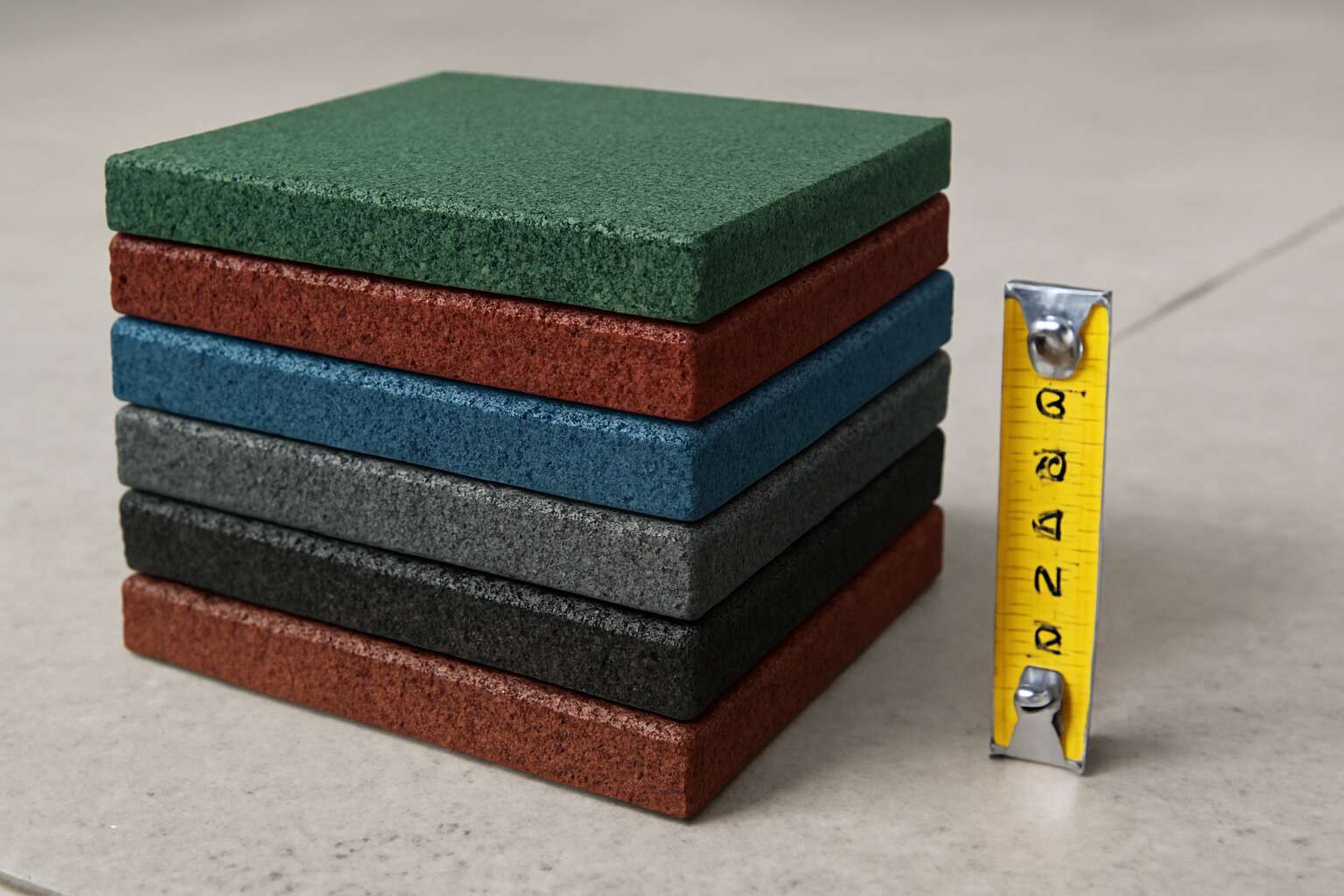Understanding Rubber Tile Packaging and Quantities
Overview of Rubber Tile Packs – What to Expect When Purchasing Rubber Tiles
When shopping for rubber tiles, understanding the packaging is crucial. Most suppliers provide detailed information about how many pieces of rubber tiles are in a pack, which varies based on the tile size and thickness. On average, a standard pack might contain anywhere from 6 to 20 tiles, but this can differ significantly depending on the manufacturer and product line. The key is to always check the packaging label or product specifications before making a purchase.
It’s worth noting that larger packs often offer better value for money, especially when covering extensive areas. For example, a typical pack of rubber tiles designed for gym flooring or playgrounds might include 10 to 15 pieces. Knowing how many pieces of rubber tiles are in a pack helps in planning the project scope and avoiding shortages mid-installation. Each pack size is tailored to meet different needs, whether for small home projects or large commercial spaces.
Some manufacturers also offer bulk options, which can be particularly advantageous for large-scale installations. When considering your purchase, ask about the typical quantity per pack and whether the tiles are uniform in size and thickness. This ensures a seamless installation and a consistent look across the entire surface area.
Common Pack Sizes and Quantities – Standard Piece Counts per Pack
Understanding rubber tile packaging is essential for anyone embarking on a flooring project, especially when considering how many pieces of rubber tiles are in a pack. The typical pack size varies depending on the manufacturer, but most commonly, you’ll find packs containing between 6 and 20 tiles. This range caters to different project scales, from small home gyms to expansive playgrounds. The exact number often hinges on the tile’s dimensions and thickness, which influence coverage and durability.
For larger installations, bulk options provide an economical advantage, often comprising 20 or more tiles per pack. These are particularly popular in commercial settings where efficiency matters. Here’s a quick overview of common pack sizes:
- Small packs: 6-10 tiles, perfect for DIY projects or small spaces.
- Medium packs: 10-15 tiles, suited for moderate areas like home gyms or small playgrounds.
- Large packs: 20+ tiles, ideal for extensive commercial or recreational spaces.
By understanding how many pieces of rubber tiles are in a pack, buyers can better plan their project scope, avoid shortages, and ensure a seamless installation. Whether you’re tackling a modest patio or a sprawling sports court, knowing pack sizes helps you make informed decisions and achieve a polished, professional finish every time.
Factors Influencing Pack Size – Material, Brand, and Product Line Variations
Understanding rubber tile packaging goes beyond just knowing the number of tiles in a pack. Variations in pack size are influenced by several factors, including material quality, brand reputation, and specific product line features. Different manufacturers may package their rubber tiles in ways that suit their target market—some favoring smaller packs for DIY enthusiasts, while others opt for bulk packaging to cater to large-scale projects.
Material composition plays a significant role in pack size. Thicker or denser rubber tiles often require more packaging considerations, which can lead to smaller, more manageable packs. Conversely, lighter and thinner tiles are usually bundled in larger quantities. Additionally, brand standards influence how many pieces of rubber tiles are in a pack. Some brands prioritize cost efficiency with bigger packs, whereas premium lines may offer fewer tiles per pack but with enhanced durability and design features.
Product line variations further dictate pack sizes. For example, modular rubber tiles designed for quick installation might come in packs of 10 to 15, while commercial-grade tiles could be sold in larger quantities, sometimes exceeding 20 tiles per pack. This flexibility ensures that buyers can select the right pack size for their specific project needs, without the hassle of overspending or shortages. Choosing the correct pack size is essential for seamless installation and achieving a professional finish—no matter the size of the project.
Determining the Number of Pieces in a Pack
Checking Product Specifications – Where to Find Pack Size Information
Determining how many pieces of rubber tiles are in a pack is crucial for budgeting and planning. The easiest way to find this information is by checking the product specifications provided by the manufacturer or supplier. Most reputable brands list pack size details clearly on their packaging or online product pages. This transparency helps buyers avoid surprises and ensures they purchase the right quantity for their project.
To locate this information, look for the section labeled “pack size” or “contents” in the product description. If you’re shopping online, the details are usually at the top of the product listing. For in-store purchases, ask a sales associate or check the packaging directly.
Keep in mind that pack sizes can vary based on the brand, material, and product line. Common pack sizes include 10, 20, or 50 pieces, but larger or smaller packs are also available. Knowing exactly how many pieces of rubber tiles are in a pack makes your project smoother and more cost-effective.
Manufacturer Packaging Standards – How Brands Decide Pack Quantities
In the realm of rubber tiles, the secret behind a smooth project lies in understanding how many pieces of rubber tiles are in a pack. Behind the scenes, manufacturers adhere to intricate packaging standards that balance practicality with market expectations. These standards are not arbitrary; they are carefully crafted based on factors such as material durability, ease of transport, and consumer convenience. For example, some brands prefer smaller packs of 10 or 20 pieces to cater to DIY enthusiasts, while larger packs of 50 or more are aimed at commercial projects.
Manufacturers often follow a logical approach when deciding pack quantities. They analyze the typical size of a project, the weight of the tiles, and shipping logistics. As a result, pack sizes tend to cluster around common project scales but can vary significantly across brands and product lines. Knowing how many pieces of rubber tiles are in a pack helps ensure your project stays within budget and reduces waste. It’s worth noting that the right pack size can turn a daunting installation into a seamless experience, all thanks to the thoughtful standards set by manufacturers.
Estimating Piece Counts for Custom Orders – If Purchasing in Bulk or Custom Sizes
When venturing into custom orders or bulk purchases of rubber tiles, understanding how many pieces of rubber tiles are in a pack can be a game-changer. Manufacturers often tailor pack sizes to meet specific project demands, which means that for large-scale commercial installations, the pack might contain 50 or more tiles. Conversely, smaller DIY projects might only require packs of 10 or 20 tiles, emphasizing flexibility and convenience.
Estimating the number of pieces needed involves more than simple math; it requires a nuanced appreciation of the installation’s scope, the tile dimensions, and shipping logistics. For those opting for custom sizes, it’s essential to communicate directly with suppliers to confirm pack quantities. Sometimes, brands offer custom pack options to match unique project specifications, ensuring you get the right amount without excess waste. This strategic approach not only optimizes budget but also simplifies the entire process, transforming what could be a logistical headache into a seamless experience.
Benefits of Knowing the Piece Count
Budget Planning and Cost Efficiency – How Pack Size Affects Your Total Costs
Knowing how many pieces of rubber tiles are in a pack can significantly influence your budget planning, turning what seems like a simple purchase into a strategic investment. When you grasp the pack size, you gain a clearer picture of the total cost, avoiding surprises that can derail project finances. It’s akin to wielding a map in uncharted territory—each pack revealing its true worth, helping you allocate resources more effectively.
Understanding this detail allows for more precise calculations, especially when considering large-scale installations. It becomes easier to compare options, ensuring you select the most cost-efficient solution without sacrificing quality. As you navigate through various supplier offerings, the knowledge of pack sizes empowers you to optimize your procurement, ensuring every rand spent is a step closer to your vision.
Accurate Space Planning – Ensuring Proper Coverage for Projects
Amidst the labyrinth of project planning, understanding how many pieces of rubber tiles are in a pack is akin to wielding a lantern in the shadows—illuminating the path toward flawless execution. Precise knowledge of pack sizes transforms vague estimates into strategic certainty, ensuring your space is covered with poetic precision. When you know the exact count, you can orchestrate your installation with confidence, avoiding the chaos of shortages or excess.
This clarity becomes even more vital when designing large-scale projects, where every tile counts and miscalculations can ripple into costly delays. Recognizing the number of tiles per pack allows for meticulous space planning—helping you to determine the exact number of packs needed and to avoid costly over-purchasing. It’s the difference between a smooth, harmonious installation and a jarring scramble for missing pieces.
Reducing Waste and Over-Order – Managing Inventory with Pack Quantities
Knowing how many pieces of rubber tiles are in a pack can significantly influence your project’s efficiency. When you have this crucial detail at your fingertips, you can accurately assess your inventory needs, reducing the risk of over-ordering or running out mid-installation. This not only streamlines your procurement process but also translates into tangible cost savings.
Reducing waste is a vital benefit of understanding pack sizes. By aligning your purchase quantities precisely with your project’s scope, you minimize excess tiles that might otherwise go unused or require disposal. Managing inventory with pack quantities ensures your supplies are optimized—no more clutter or shortages disrupting your timeline.
This knowledge also allows for precise budgeting. When you understand how many pieces of rubber tiles are in a pack, you can forecast expenses with confidence, avoiding surprises that could derail your plans. Ultimately, it’s about turning an obscure detail into a strategic advantage, making your installation process smoother and more predictable.
Additional Tips for Purchasing Rubber Tiles
Comparing Pack Sizes Across Brands – Finding the Best Value
When diving into the world of rubber tiles, one question echoes louder than a gym’s echo chamber: how many pieces of rubber tiles are in a pack? It’s a surprisingly critical detail, especially when you’re trying to avoid the nightmare of under-ordering or drowning in surplus. Different brands often have their own secret recipes—some pack 10, others 20, and a few go as high as 50 pieces per pack. The key is to compare pack sizes across brands to find the best value for your buck.
To truly optimize your purchase, it’s wise to consider how many pieces of rubber tiles are in a pack in relation to your project’s scope. Some manufacturers may offer bulk packs with larger piece counts for commercial installations, while smaller packs suit DIY enthusiasts with limited space.
- Check the packaging standards.
- Review the product specifications carefully.
Knowing these details helps prevent surprises when you’re knee-deep in your installation.
Understanding Shipping and Handling – Impacts of Pack Size on Delivery
Understanding how many pieces of rubber tiles are in a pack can significantly impact your project’s success and budget. Shipping and handling costs often hinge on pack size—larger packs might be more economical but can be cumbersome to transport. It’s vital to consider how the pack size affects delivery, especially if you’re ordering in bulk for a commercial installation. Smaller packs, while easier to manage, may increase overall shipping expenses, eroding potential savings.
In some cases, the weight and dimensions of the pack influence courier decisions, delays, or additional charges. Therefore, always verify the exact pack size and weight before purchasing. This helps prevent surprises when arranging logistics or estimating costs. Remember, knowing how many pieces of rubber tiles are in a pack isn’t just about quantity; it’s about streamlining your entire supply chain. A well-informed choice ensures your project remains on schedule and within budget—no matter the size of your order or the intricacies of delivery logistics.
Where to Buy Rubber Tiles in Packs – Online Retailers, Specialty Stores, and Bulk Suppliers
When hunting for rubber tiles, the question of “how many pieces of rubber tiles are in a pack” often feels like deciphering a secret code. The truth is, pack sizes can vary wildly depending on where you buy—online retailers, specialty stores, or bulk suppliers. Each source has its own packaging standards, making it a bit of a treasure hunt to find the perfect fit for your project.
For those seeking consistency and simplicity, most manufacturers offer standard pack sizes that typically include 4, 6, or 8 pieces of rubber tiles. However, if you’re planning a large-scale commercial installation, you might encounter bulk options where a single pack can contain dozens or even hundreds of pieces. Knowing precisely how many pieces of rubber tiles are in a pack helps you plan your space accurately and avoid the dreaded over- or under-ordering dilemma.
Online retailers often provide detailed product specifications, making it easier to determine the exact pack size. Specialty stores, on the other hand, may offer more customized options, allowing you to purchase packs tailored to your project’s scale. Meanwhile, bulk suppliers excel at providing larger quantities, which can lead to significant savings—if you manage to juggle the logistics of such hefty packs.




0 Comments